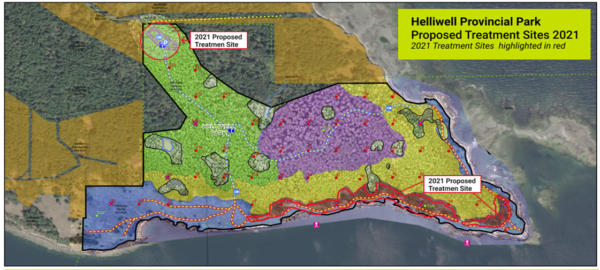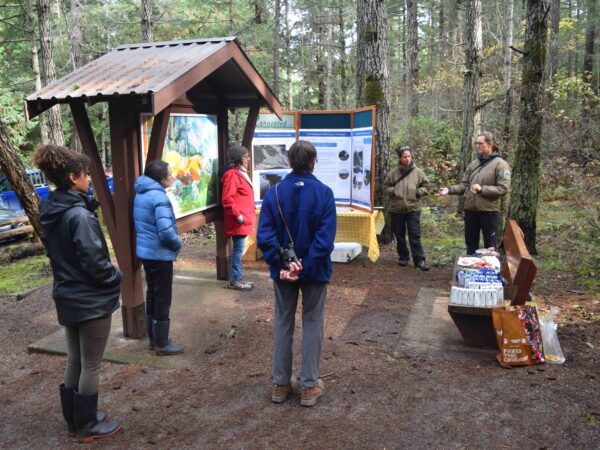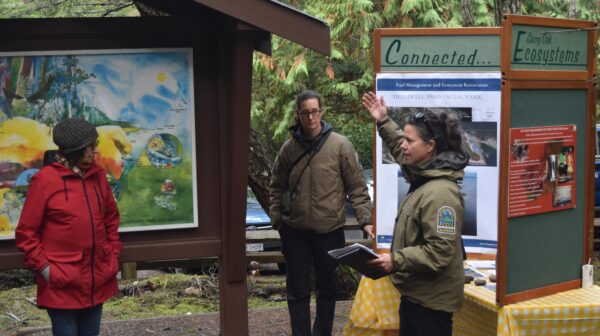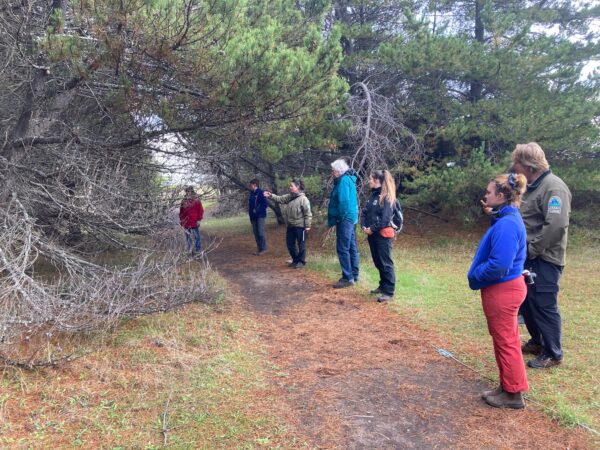Fuel Management and Ecological Restoration go Hand in Hand at Helliwell Provincial Park
By Chris Junck, Taylor’s Checkerspot Butterfly Recovery Project Team
Historically, First Nations used fire as a tool to maintain important plants and other species associated with open Garry Oak woodlands and meadows. In the absence of First Nation’s land management practices, and decades of fire suppression in the area, the fuel hazard has increased within the park with the number of dead and dying shore pine along the coastline trail east towards St. Johns Point.
This fall, BC Parks is embarking on a multi-year project to meet fuel management and ecological restoration objectives in Helliwell. The project is guided by the Helliwell Provincial Park Ecosystem Based Plan (2001) and Helliwell Provincial Park Wildfire Threat Assessment and Fuel Management Prescription (2021). It was introduced to representatives of the Hornby Island Provincial Parks Committee, Conservancy Hornby Island and Hornby Island Natural History Centre during a public information session in October. “We’re taking a slow and gradual approach to ensure park values are maintained and will focus on high wildfire risk areas first”, said BC Parks senior ranger Heather Steere.

The proposed sites for selectively reducing fire fuels in 2021-22 are scattered throughout the areas within the red boundary lines on the map.

Erica McClaren, BC Parks conservation specialist, told the group about the Taylor’s checkerspot butterfly recovery project activities and a hydrology study that took place in the park in 2021. Photo by Chris Junck.
Heather Steere and conservation specialist Erica McClaren described other components of the plan:
- Focus will be on reducing fine fuels and ladder fuels, while enhancing ecological values.
- Selective, multi-year manual thinning and limbing of Douglas-fir and shore pine.
- Iconic trees, Garry Oak, juniper and arbutus trees will not be negatively impacted.
- On site pile burning will be used to dispose of thinning debris along the coastal bluff trail area.
- Continuous management of invasive species throughout the park.
- Replanting and seeding of burn piles using native species.
- This work will support and enhance the Garry Oak and arbutus ecosystem.

BC Parks senior ranger Heather Steere discussed the various potential wildfire risks and the need to reduce the fuel load in the target areas while enhancing the ecological values. Photo by Chris Junck.
Heather Steere invited the public to provide BC Parks with a list of locations within Helliwell that are significant for the community, and locals have flagged these areas to prevent unintentional damage during the project. A contractor has been hired and plans to begin limbing and thinning in mid-December and January with work completed by mid-February at the latest.
The Taylor’s Checkerspot Butterfly Recovery Project Team and BC Parks thank the Cowichan Tribes, Halalt, Homalco, K’ómoks, Lake Cowichan, Lyackson, Penelakut, Qualicum, Snaw’Naw’As, Stz’uminus, Tla’amin, We Wai Kai, and We Wai Kum First Nations, for allowing us to restore ecosystems in their traditional territories. Thanks to Ilze Raudzins, Tina Wai, Neil Wilson, Rebecca Benjamin-Carey, and Serena Laskin for their insightful comments and questions during the October information session in Helliwell Provincial Park.

During a tour of the potential target fuel management sites, Heather Steere identified the kinds of fuels that need to be reduced and areas where ecological values will be enhanced. Photo by Erica McClaren.
You can find out more about fuel management or other aspects of the Helliwell Provincial Park Ecosystem Based Plan here.